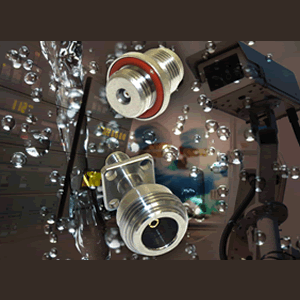One Waterproof Connector Does Not Fit All
A host of variables define a waterproof connector. Here’s how one company helps its customers get exactly what they need.
Roy Phillips, Managing Director, Intelliconnect
When a customer asks a supplier for a waterproof connector, their exact requirements are often unclear. In fact, many customers find the specific factors involved in waterproofing tech a mystery. A typical conversation may go something like this:
“Hello, I need a waterproof connector.”
“What exactly do you mean by ‘waterproof’?”
“What different types of waterproof are there?”
“Well, there is splash-proof, jet-spray-proof, rain-proof, swift-immersion-proof, continuous-immersion-proof, deep-water/high-pressure proof, all of the above in a mated condition, and all of the above in an unmated condition (sealed internally). Also, do you need a cable plug, bulkhead jack, adapter, or cable assembly? Is your application in a saltwater environment?”
“Ah, I didn’t realize there were so many choices.”
Therein lies the problem that many users and specifiers of waterproof interconnects face. They don’t really know what they want, and thus often end up specifying a totally unsuitable product.
 In a world where RF, microwave, and other technologies are increasingly used externally, in harsh environments, and in situations where fluid ingress is an issue, it is critical that customers are clear about their requirements. It’s equally important to select a manufacturer/supplier with expertise in the many different methods used to ensure that the integrity of a connector’s seals are sufficient to meet the needs of the application.
In a world where RF, microwave, and other technologies are increasingly used externally, in harsh environments, and in situations where fluid ingress is an issue, it is critical that customers are clear about their requirements. It’s equally important to select a manufacturer/supplier with expertise in the many different methods used to ensure that the integrity of a connector’s seals are sufficient to meet the needs of the application.
One area that is often forgotten is the unsuitability of certain materials in certain environments. For example, connector products for saltwater applications should be made from materials that offer corrosion resistance, such as nickel, aluminum, and bronze, and should be combined with specialized rubber sealing gaskets and O-rings designed to withstand the rigors of saltwater environments.
Two case studies demonstrate some of the challenges that guide the design of waterproof connectors.
A major international manufacturer of RF implant technology approached Intelliconnect with a request for a rugged, reliable, and quick-disconnect waterproof connector that would be suitable for use in a medical application and small enough to be installed in a Cochlear implant. Often referred to as a bionic ear, a Cochlear implant is a surgically implanted device that enables severely deaf people to hear again. The company wanted a waterproof interconnect system to prevent users from having to remove their equipment, and essentially become deaf again, when bathing, swimming, or showering.
Their main difficulty in providing users with this capability was the interconnect system, which was “as leaky as a rusty bucket.” In response, we created a suite of application-specific connectors within eight weeks. These connectors were rugged, rated for up to 3,000 matings, waterproof to IP68 and NEMA 6P, and based on the proven MCX RF connector interface, and resulted in one happy customer and many thousands of happy consumers in the field with zero failures.
In another example, a customer in the defense market who manufactured personal locator beacons (PLBs) asked us to design a range of seven TNC connectors/adapters for a new personal locator beacon they designed for Air Force pilots to use when they eject into the sea. The brief was simple: The beacons had to work at a depth of 10 meters for a minimum of four hours for pilots be located and rescued. The conversation went something like this:
“The quantities are quite small — in the hundreds, in fact.”
“No problem there; we’ll make a one-off if you want it!”
“Yes, but they need to be waterproof, both mated and unmated.”
“That’s fine, a piece of hermetic glass in the rear end will do the trick.”
“No, we’ve already had a look at those and they’re far too expensive. We don’t want it to cost too much more than a standard connector. Oh, and because it’s a safety-related military product, we need it to be highly reliable, and we don’t want to pay an NRE charge.”
“OK, anything else?” we asked in trepidation.
“Yes, we need product on our dock in eight weeks.”
To design, develop, sample, machine, plate-assemble, and deliver a range of four different connectors with a completely new feature in the space of eight weeks is an interesting problem. The connectors themselves were relatively simple bulkhead jacks and right angle cable plugs. The problem, of course, was how to make them waterproof. The jack and the cabled plugs both presented a different set of challenges. The designers needed to:
- Waterproof the bulkhead jacks so that there was no ingress of water into the beacon when unmated.
- Waterproof the plugs so that there was no ingress of water into the cable, either through the face of the connector or the cable crimp area.
- Ensure that materials were capable of withstanding prolonged exposure to salt water without jeopardizing the integrity of the connector or the seal.
- Design the product so that it could be manufactured in a cost-effective manner.
- Above all, prove the integrity of the design at the highest possible safety levels. This was a potential life-or-death situation product; the reliability of these interconnects had to be 100% without exception.
Many late nights, meetings with the customer, transatlantic teleconferences, trials and tests, and a huge amount of advice from material specialists led to a final design. Like most great ideas, it was ultimately a very simple one. Early on in the design process, the use of O-rings was raised as a potential way of internally sealing the connectors, but it was quickly discarded as being too simplistic and potentially unreliable. The sealing properties of PTFE (Teflon) were also considered, epoxy sealing was investigated, glass was reviewed, and a variety of other ideas — some very strange — were brainstormed, and all were discarded. Were we to fail? No, failure was not an option. Our pride as engineers (not to mention a nice order) was at stake here and we would not be beaten. But what could we do?
“What about that idea of using O-rings?”
“Let’s look at it again.”
With much help from our O-ring vendor, a special material was specified that would conform to sealing and other mechanical requirements. Other components were specially designed, FMEAs and design reviews were carried out, and we finally had an answer.
Initial prototypes were made (not without some considerable pain) and our Rube Goldberg-style test equipment was brought into play. Jacks were tested using air at a pressure of 3 bar for 12 hours (twice the pressure and time that the customer required) with no failures.
The right-angle cable plugs proved more difficult. The internal sealing was fine, but even using a glue-lined heat-shrink sleeve, a small amount of water seeped into the cable after prolonged immersion under pressure.” The solution here was to mould a special boot over the connector and cable.
Samples were dispatched to the customer and within days the good news came back: They were happy. Seven weeks and five days after the original request, we were able to deliver the first production quantity with two days to spare. The Intelliconnect Pisces connector range was born.
In addition to safety, integrity, and customer satisfaction, cost is also an important driver in the connector design process. However, given reasonable volume, costs for waterproof products, whether standard off-the-shelf or special designs, can be surprisingly competitive with non-waterproof products. The customer just needs to know exactly what they mean by waterproof.
Recently posted:
[related_posts limit=”10″]






